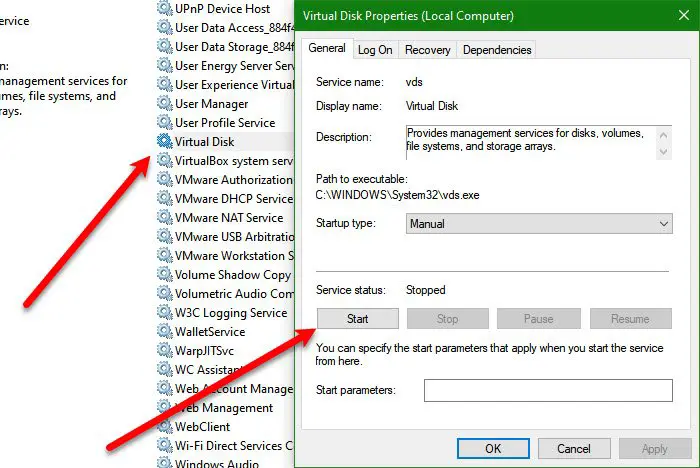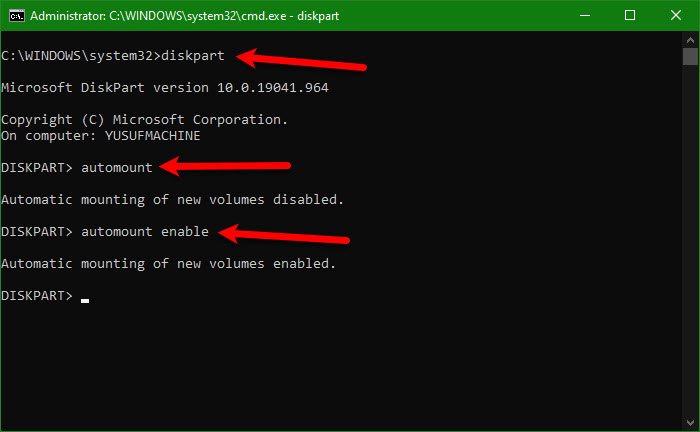Usually, when you plug an external to your Windows 11/10 computer, it automatically assigns a drive letter to it. However, many Windows users are experiencing peculiar behavior as their system fails to assign a letter to the newly installed driver. Hence, in this article, we are going to see some easy ways to fix Windows not assigning Drive letters automatically.
Why is Windows not assigning Drive letters?
There are certain services and features that allow your computer to function normally, that is to install the driver, assign a drive letter, etc, when a new driver is installed. So, you need to check them and see the ones meant to be enabled are enabled and the ones that should be disabled are disabled.
Windows not assigning Drive letters automatically
If Windows is not assigning Drive letters automatically, then follow these suggestions to fix the issue:
- Enable Virtual Disk
- Check if Automatic Mounting of New Volume is enabled
- Make sure to disable ‘Hidden’ and ‘No Default Driver Letter’
Let us talk about them in detail.
1] Enable Virtual Disk

If the Virtual Disk service is disabled on your computer, you will face many disk issues including letters not being assigned to the installed disks. Hence, you need to enable it. To do that, you can use the following steps.
- Open Services from the Start Menu.
- Look for the Virtual Disk service, right-click on it, and select Properties.
- Now, click Start if the Service Status is Stopped. Even if it is enabled, it is recommended to restart the service and see if the issue persists.
There is another way to enable the service in question. That’s by executing some commands. So, open Command Prompt as an administrator and run the following commands.
Run the following command to know the status of Virtual Disk Service.
sc query vds
Now, to enable it, run the given command.
net start vds
Finally, try reinstalling the driver(plug-out and plug-in) and see if the issue persists.
2] Check if Automatic Mounting of New Volumes is enabled

If the issue still persists after executing the first solution, you need to make sure that Automatic Mounting of New Volumes is enabled, otherwise, letters won’t be assigned to drives.
To do that, open Command Prompt as an administrator and use the following command to enter Diskpart.
diskpart
Afterward, we need to check if automount is enabled, for that, execute the following command.
automount
Now, enable it with the help of the following command.
automount enable
Finally, exit Diskpart with the following command.
exit
Now, you can restart your computer and check if the issue persists.
3] Make sure to disable ‘Hidden’ and ‘No Default Driver Letter’
If you are still not able to see the drive letter then maybe your “Hidden” and “No Default Drive Letter” attributes of that particular volume are enabled. So, disable them with the help of the given commands.
Diskpart
list disk
select disk 1
Note: Change ‘1’ with the number associated with your disk. If you can’t fathom which disk to choose, look at their respective sizes to get a clear idea.
list part
Note: Don’t use the above command, if you don’t have more than one partition.
select partition 2
Note: Replace ‘2’ with the number associated with the partition in question.
attributes volume
Now, see if “Hidden” and “No Default Drive Letter” attributes are enabled, if they are, run th following commands simultaneously.
attributes volume clear NoDefaultDriveLetter
attributes volume clear hidden
Finally, type ‘exit’, hit Enter, restart your computer, and see if the issue persists.
Hopefully, you are able to fix the error with the help of the solutions given in this article.
Read: How to Show Drive Letters first before Drive Names in Explorer.
How to manually assign a Disk?
To assign a letter manually or change the letter you need to perform the following steps.
- Open Computer Management by Win + X > Computer Management.
- Expand Storage and click Disk Management.
- Right-click on the disk with no letter, and select Change Drive Letters and Paths.
- Click Add, select Assign the following drive letter and select a letter of your choice.
- Finally, click OK.
That’s it!
Read Next: USB 3.0 External Hard Drive not recognized in Windows.